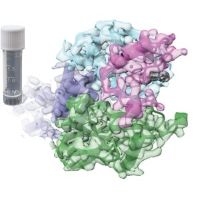Specification
| Description | Recombinant protein from the full-length sequence of homo sapiens cullin 4B (CUL4B), transcript variant 1 (NM_003588). |
| Organism | Homo sapiens (Human) |
| Expression Host | Human Cells |
| Tag Info | His or DYKDDDDK. Please contact us if you need further information or require specific designed tag. |
| Purity | Greater than 90% by SDS-PAGE gel |
| Uniprot ID | Q13620 |
| Entry Name | CUL4B_HUMAN |
| Gene Names | CUL4B KIAA0695 |
| Alternative Gene Names | KIAA0695 |
| Alternative Protein Names | Cullin-4B (CUL-4B) |
| Application | Antigens, Western, ELISA and other in vitro binding or in vivo functional assays, and protein-protein interaction studies; For research & development use only! |
| Buffer | Purified protein formulated in a sterile solution of PBS buffer, pH7.2, without any preservatives |
| Endotoxin | Endotoxin level is < 0.1 ng/µg of protein (<1EU /µg) |
| Length | 913 |
| Molecular Weight(Da) | 103982 |
| Protein Sequence | (The sequence of expressed protein may have some variation from the sequence shown below. Please contact us for the exact sequence.) MMSQSSGSGDGNDDEATTSKDGGFSSPSPSAAAAAQEVRSATDGNTSTTPPTSAKKRKLNSSSSSSSNSSNEREDFDSTSSSSSTPPLQPRDSASPSTSSFCLGVSVAASSHVPIQKKLRFEDTLEFVGFDAKMAEESSSSSSSSSPTAATSQQQQLKNKSILISSVASVHHANGLAKSSTTVSSFANSKPGSAKKLVIKNFKDKPKLPENYTDETWQKLKEAVEAIQNSTSIKYNLEELYQAVENLCSYKISANLYKQLRQICEDHIKAQIHQFREDSLDSVLFLKKIDRCWQNHCRQMIMIRSIFLFLDRTYVLQNSMLPSIWDMGLELFRAHIISDQKVQNKTIDGILLLIERERNGEAIDRSLLRSLLSMLSDLQIYQDSFEQRFLEETNRLYAAEGQKLMQEREVPEYLHHVNKRLEEEADRLITYLDQTTQKSLIATVEKQLLGEHLTAILQKGLNNLLDENRIQDLSLLYQLFSRVRGGVQVLLQQWIEYIKAFGSTIVINPEKDKTMVQELLDFKDKVDHIIDICFLKNEKFINAMKEAFETFINKRPNKPAELIAKYVDSKLRAGNKEATDEELEKMLDKIMIIFRFIYGKDVFEAFYKKDLAKRLLVGKSASVDAEKSMLSKLKHECGAAFTSKLEGMFKDMELSKDIMIQFKQYMQNQNVPGNIELTVNILTMGYWPTYVPMEVHLPPEMVKLQEIFKTFYLGKHSGRKLQWQSTLGHCVLKAEFKEGKKELQVSLFQTLVLLMFNEGEEFSLEEIKQATGIEDGELRRTLQSLACGKARVLAKNPKGKDIEDGDKFICNDDFKHKLFRIKINQIQMKETVEEQASTTERVFQDRQYQIDAAIVRIMKMRKTLSHNLLVSEVYNQLKFPVKPADLKKRIESLIDRDYMERDKENPNQYNYIA |
Background
| Function | FUNCTION: Core component of multiple cullin-RING-based E3 ubiquitin-protein ligase complexes which mediate the ubiquitination and subsequent proteasomal degradation of target proteins (PubMed:14578910, PubMed:16322693, PubMed:16678110, PubMed:18593899, PubMed:29779948, PubMed:30166453, PubMed:33854232, PubMed:33854239, PubMed:22118460). The functional specificity of the E3 ubiquitin-protein ligase complex depends on the variable substrate recognition subunit (PubMed:14578910, PubMed:16678110, PubMed:18593899, PubMed:29779948, PubMed:22118460). CUL4B may act within the complex as a scaffold protein, contributing to catalysis through positioning of the substrate and the ubiquitin-conjugating enzyme (PubMed:14578910, PubMed:16678110, PubMed:18593899, PubMed:22118460). Plays a role as part of the E3 ubiquitin-protein ligase complex in polyubiquitination of CDT1, histone H2A, histone H3 and histone H4 in response to radiation-induced DNA damage (PubMed:14578910, PubMed:16678110, PubMed:18593899). Targeted to UV damaged chromatin by DDB2 and may be important for DNA repair and DNA replication (PubMed:16678110). A number of DCX complexes (containing either TRPC4AP or DCAF12 as substrate-recognition component) are part of the DesCEND (destruction via C-end degrons) pathway, which recognizes a C-degron located at the extreme C terminus of target proteins, leading to their ubiquitination and degradation (PubMed:29779948). The DCX(AMBRA1) complex is a master regulator of the transition from G1 to S cell phase by mediating ubiquitination of phosphorylated cyclin-D (CCND1, CCND2 and CCND3) (PubMed:33854232, PubMed:33854239). The DCX(AMBRA1) complex also acts as a regulator of Cul5-RING (CRL5) E3 ubiquitin-protein ligase complexes by mediating ubiquitination and degradation of Elongin-C (ELOC) component of CRL5 complexes (PubMed:30166453). Required for ubiquitination of cyclin E (CCNE1 or CCNE2), and consequently, normal G1 cell cycle progression (PubMed:16322693, PubMed:19801544). Regulates the mammalian target-of-rapamycin (mTOR) pathway involved in control of cell growth, size and metabolism (PubMed:18235224). Specific CUL4B regulation of the mTORC1-mediated pathway is dependent upon 26S proteasome function and requires interaction between CUL4B and MLST8 (PubMed:18235224). With CUL4A, contributes to ribosome biogenesis (PubMed:26711351). {ECO:0000269|PubMed:14578910, ECO:0000269|PubMed:16322693, ECO:0000269|PubMed:16678110, ECO:0000269|PubMed:18235224, ECO:0000269|PubMed:18593899, ECO:0000269|PubMed:19801544, ECO:0000269|PubMed:22118460, ECO:0000269|PubMed:26711351, ECO:0000269|PubMed:29779948, ECO:0000269|PubMed:30166453, ECO:0000269|PubMed:33854232, ECO:0000269|PubMed:33854239}. |
| Pathway | Protein modification; protein ubiquitination. |
| Protein Families | Cullin family |
| Tissue Specificity |
QC Data
| Note | Please contact us for QC Data |
| Product Image (Reference Only) |  |

